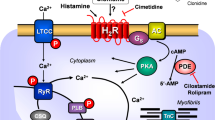Abstract
The effects of two histamine H2-receptor antagonists, ramitidine and cimetidine, on ventricular arrhythmias induced by acute coronary artery ligation and by aconitine infusion were studied in pentobarbitone-anaesthetized rats. The changes in arterial blood pressure and heart rate were also observed. It was found that both drugs significantly reduced the incidence, and prolonged the time of onset, of ventricular tachycardia and ventricular fibrillation following acute coronary artery ligation; however, they did not significantly alter the incidence or time of onset of ventricular dysrhythmias caused by aconitine infusion. These findings further support the hypothesis that histamine release may contribute to the genesis of early ventricular arrhythmias resulting from acute myocardial ischaemia. Since the decreased blood pressure induced by coronary artery ligation was not significantly prevented by pretreatment with either histamine H2-receptor blocker, this suggests that histamine may not be responsible for the blood pressure changes during acute myocardial ischaemia.
Similar content being viewed by others
References
R.A. Riemersma,Myocardial catecholamine release in acute myocardial ischaemia; relationship to cardiac arrhythmias. In Early Arrhythmias Resulting from Myocardial Ischaemia, pp. 125–138 (Ed. J.R. Parratt). Macmillan, New York (1982).
S.J. Coker,Early ventricular arrhythmias arising from acute myocardial ischaemia; possible involvement of prostaglandins and thromboxanes. In Early Arrhythmias Resulting from Myocardial Ischaemia, pp. 219–237 (Ed. J.R. Parratt). Macmillan, New York 1982.
O. Fagbemi, I. Lepran, J.R. Parratt andL. Szekeres,Naloxone inhibits early arrhythmias resulting from acute coronary ligation, Br. J. Pharmac.76, 504–506 (1982).
T. Podzuweit,Early arrhythmias resulting from acute myocardial ischaemia; possible role of cyclic AMP. In Early Arrhythmias Resulting from Myocardial Ischaemia, pp. 171–198 (Ed. J.R. Parratt). Macmillan, New York 1982.
R.W. Gristwood, J.C.R. Lincoln, D.A.A. Owen andI.R. Smith,Histamine release from human right atrium, Br. J. Pharmac.74, 7–9 (1981).
G.V. Anrep, G.S. Barsoum andM. Talaat,Liberation of histamine by the heart muscle, J. Physiol., Lond.86, 431–451 (1936).
J.P. Trzeciakowski andR. Levi,Reduction of ventricular fibrillation threshold by histamine: resolution into separate H 1-and H 2-mediated components, J. Pharmac. exp. Ther.223, 774–783 (1982).
A.S. Harris,Delayed development of ventricular ectopic rhythms following experimental coronary occlusion, Circulation1, 1318–1328 (1950).
M.S. Gaide, C.B. Altman, J.S. Cameron, C.J. Kaiser, R.J. Myerburg andA.L. Bassett,Histamine modification of spontaneous rate and rhythm in infarcted canine ventricle, Agents and Actions15, 488–493 (1984).
S. Dai,Effects of SK&F 93479 on experimentally induced ventricular arrhythmias in dogs, rats and mice, Agents and Actions15, 131–136 (1984).
G. Coruzzi, E. Poli, F. Fesani, D. Medici andG. Bertaccini,Negative inotropic effect of some H 2-receptor antagonists on the isolated human atria, Experientia39, 1284–1286 (1983).
T.E. Mertz andH.R. Kaplan,Pirmenol hydrochloride (CI-845) and reference antiarrhythmic agents: Effects on early ventricular arrhythmias after acute coronary artery ligation in anesthetized rats, J. Pharmac. exp. Ther.223, 580–586 (1982).
C.R. Ganellin,Chemistry and structure-activity relationships of drugs acting at histamine receptors. In Pharmacology of Histamine Receptors, pp. 10–102 (Ed. C.R. Ganellin and M.E. Parsons). Wright·PSG, London 1982.
N.K. Dadkar andB.K. Bhattacharya,A rapid screening procedure for antiarrhythmic activity in the mouse, Archs int. Pharmacodyn.212, 297–301 (1974).
R. Levi, D.A.A. Owen andJ. Trzeciakowski,Actions of histamine on the heart and vasculature. In Pharmacology of Histamine Receptors, pp. 236–297 (Ed. C.R. Ganellin and M.E. Parsons). Wright·PSG, London 1982.
S. Dai,A study of the actions of histamine on the isolated rat heart, Clin. Exp. Pharmac. Physiol.3, 359–367 (1976).
J. Lecomite andA. Cession-Fossion,Absence de reactions, anaphylactiques localisées au myocarde du rat, C.R. Soc. Biol. (Paris)164, 1420–1422 (1970).
S. Dai,Protection by SK& F 93479 against the haemodynamic effects of coronary artery ligation in dogs, Pharmac. Res. Comm.16, 987–998 (1984).
Author information
Authors and Affiliations
Rights and permissions
About this article
Cite this article
Dai, S. Effects of ranitidine and cimetidine on experimentally induced ventricular arrhythmias in anaesthetized rats. Agents and Actions 17, 460–465 (1986). https://doi.org/10.1007/BF01965514
Received:
Accepted:
Issue Date:
DOI: https://doi.org/10.1007/BF01965514




